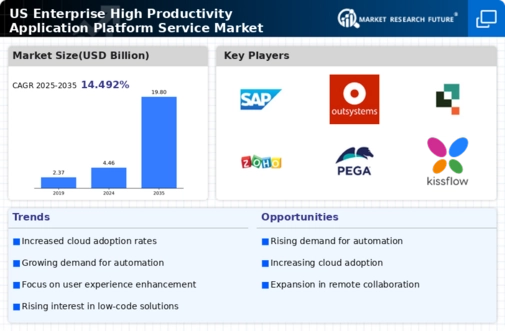Growing Emphasis on User Experience
User experience (UX) has emerged as a critical focus for organizations, driving the enterprise high-productivity-application-platform-service market. Companies recognize that applications must not only function effectively but also provide an intuitive and engaging experience for users. Research indicates that organizations prioritizing UX can see a 200% increase in user engagement and satisfaction. This growing emphasis on UX compels businesses to adopt high-productivity application platforms that facilitate the design and development of user-centric applications. As a result, the enterprise high-productivity-application-platform-service market is likely to expand as companies invest in tools that enhance the overall user experience and foster customer loyalty.
Need for Enhanced Collaboration Tools
The demand for enhanced collaboration tools is a driving force in the enterprise high-productivity-application-platform-service market. As remote work becomes more prevalent, organizations require platforms that facilitate seamless collaboration among teams. Effective collaboration tools can lead to a 25% increase in team productivity, as they enable real-time communication and project management. This need for improved collaboration is pushing businesses to adopt high-productivity application platforms that integrate various collaboration features. Consequently, the enterprise high-productivity-application-platform-service market is expected to grow as companies seek solutions that support their remote and hybrid work environments.
Integration of Artificial Intelligence
The integration of artificial intelligence (AI) into application development processes is a significant driver for the enterprise high-productivity-application-platform-service market. AI technologies enhance automation, improve decision-making, and streamline workflows, thereby increasing overall productivity. Recent studies suggest that organizations leveraging AI in their development processes can achieve up to a 40% reduction in time-to-market for new applications. This capability allows businesses to remain competitive in a rapidly evolving landscape. Consequently, the enterprise high-productivity-application-platform-service market is likely to see a surge in demand as companies seek to harness AI to optimize their application development efforts and improve operational efficiency.
Focus on Cost Efficiency and Resource Optimization
Cost efficiency and resource optimization are paramount concerns for organizations, influencing the enterprise high-productivity-application-platform-service market. Companies are increasingly looking for ways to reduce operational costs while maximizing resource utilization. High-productivity application platforms offer the potential to streamline development processes, which can lead to a 30% reduction in development costs. This focus on cost efficiency drives organizations to invest in platforms that enable them to achieve more with fewer resources. As a result, the enterprise high-productivity-application-platform-service market is likely to see continued growth as businesses prioritize solutions that align with their financial objectives.
Increased Demand for Rapid Application Development
The enterprise high-productivity-application-platform-service market experiences heightened demand for rapid application development solutions. Organizations are increasingly seeking to accelerate their digital transformation initiatives, which necessitates the swift deployment of applications. According to recent data, the market for low-code platforms is projected to grow at a CAGR of 28% through 2026, indicating a robust appetite for tools that facilitate faster development cycles. This trend is driven by the need for businesses to respond quickly to market changes and customer demands. As a result, the enterprise high-productivity-application-platform-service market is positioned to benefit from this urgency, as companies prioritize solutions that enable them to innovate and deliver applications at an unprecedented pace.

























Leave a Comment